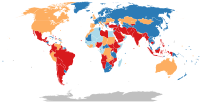
Photo from wikipedia
The ongoing COVID-19 pandemic has overwhelmingly demonstrated the need to accurately evaluate the effects of implementing new or altering existing nonpharmaceutical interventions. Since these interventions applied at the societal level… Click to show full abstract
The ongoing COVID-19 pandemic has overwhelmingly demonstrated the need to accurately evaluate the effects of implementing new or altering existing nonpharmaceutical interventions. Since these interventions applied at the societal level cannot be evaluated through traditional experimental means, public health officials and other decision makers must rely on statistical and mathematical epidemiological models. Nonpharmaceutical interventions are typically focused on contacts between members of a population, and yet most epidemiological models rely on homogeneous mixing which has repeatedly been shown to be an unrealistic representation of contact patterns. An alternative approach is individual based models (IBMs), but these are often time intensive and computationally expensive to implement, requiring a high degree of expertise and computational resources. More often, decision makers need to know the effects of potential public policy decisions in a very short time window using limited resources. This paper presents a computation algorithm for an IBM designed to evaluate nonpharmaceutical interventions. By utilizing recursive relationships, our method can quickly compute the expected epidemiological outcomes even for large populations based on any arbitrary contact network. We utilize our methods to evaluate the effects of various mitigation measures in the District of Columbia, USA, at various times and to various degrees. Rcode for our method is provided in the supplementry material, thereby allowing others to utilize our approach for other regions.
Journal Title: PLoS ONE
Year Published: 2020
Link to full text (if available)
Share on Social Media: Sign Up to like & get
recommendations!